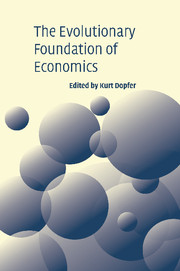Book contents
- Frontmatter
- Contents
- List of contributors
- List of figures
- List of tables
- Prolegomenon
- I Ontological foundations
- II A framework for evolutionary analysis
- 8 Towards an evolutionary theory of production
- 9 Learning in evolutionary environments
- 10 The evolutionary perspective on organizational change and the theory of the firm
- 11 The self-organizational perspective on economic evolution: a unifying paradigm
- 12 Evolutionary concepts in relation to evolutionary economics
- 13 Understanding social and economic systems as evolutionary complex systems
- 14 Perspectives on technological evolution
- 15 Evolutionary economic dynamics: persistent cycles, disruptive technology and the trade-off between stability and complexity
- 16 Evolutionary theorizing on economic growth
- Index of topics
- Index of names
- References
15 - Evolutionary economic dynamics: persistent cycles, disruptive technology and the trade-off between stability and complexity
Published online by Cambridge University Press: 22 September 2009
- Frontmatter
- Contents
- List of contributors
- List of figures
- List of tables
- Prolegomenon
- I Ontological foundations
- II A framework for evolutionary analysis
- 8 Towards an evolutionary theory of production
- 9 Learning in evolutionary environments
- 10 The evolutionary perspective on organizational change and the theory of the firm
- 11 The self-organizational perspective on economic evolution: a unifying paradigm
- 12 Evolutionary concepts in relation to evolutionary economics
- 13 Understanding social and economic systems as evolutionary complex systems
- 14 Perspectives on technological evolution
- 15 Evolutionary economic dynamics: persistent cycles, disruptive technology and the trade-off between stability and complexity
- 16 Evolutionary theorizing on economic growth
- Index of topics
- Index of names
- References
Summary
Introduction: bridging the gap between economics and biology
Alfred Marshall once remarked that economics should be considered closer to biology than to mechanics (Marshall, 1890). Living systems have two essential features: life rhythms, and the birth/death process. However, the current economic framework is far from Marshall's dream: economic order is widely formulated by a steady-state solution plus random noise. Can we bridge the gap between equilibrium economics and evolutionary biology?
There are two fundamental problems in theoretical economics: the nature of persistent business cycles, and the diversity in developing the division of labour. To study these problems, there are two different perspectives in economic dynamics: the equilibrium-mechanical approach, and the evolution-biological approach.
The existence of persistent business cycles and chronic excess capacity is hard to explain by using equilibrium models in macroeconometrics. External noise cannot maintain persistent cycles in the Frisch model (see Chen, 1999); aggregate fluctuations in the Lucas micro-foundations model are too weak for generating large macro-fluctuations according to the principle of large numbers (Lucas, 1972, Chen, 2002); and random walk and Brownian motion are not capable of explaining persistent fluctuations in macro-indicators (Chen, 2001). Adam Smith once observed that the division of labour was limited by the extent of the market (Smith, 1776). George Stigler noted that the above Smith theorem was not compatible with the Smith theory of the ‘invisible hand’ (Stigler, 1951). Joseph Needham asked why capitalism and science originated in Western Europe, not in China or other civilizations (Needham, 1954).
- Type
- Chapter
- Information
- The Evolutionary Foundations of Economics , pp. 472 - 505Publisher: Cambridge University PressPrint publication year: 2005
References
- 9
- Cited by

